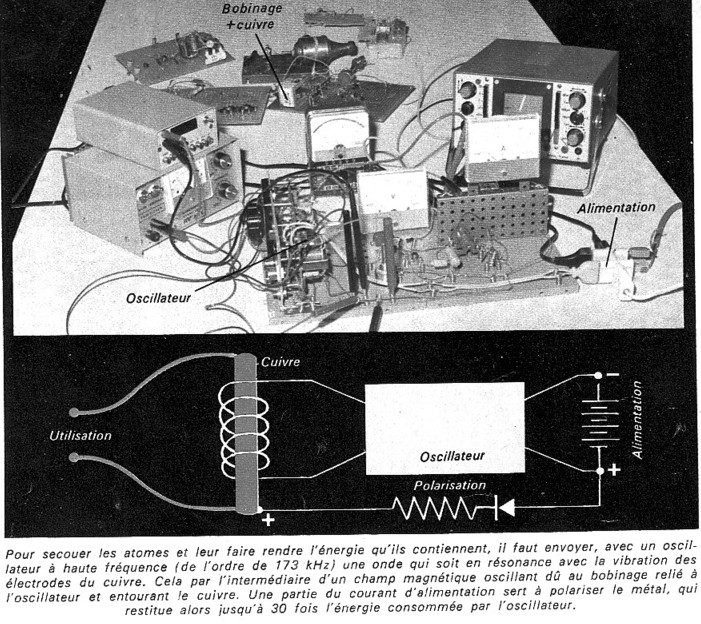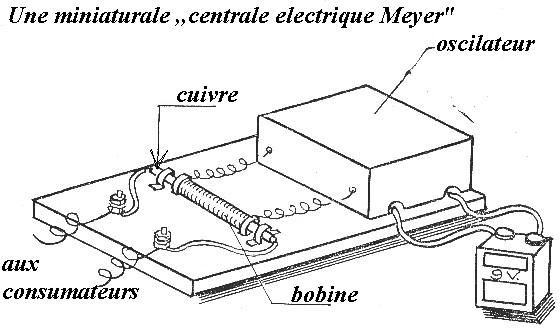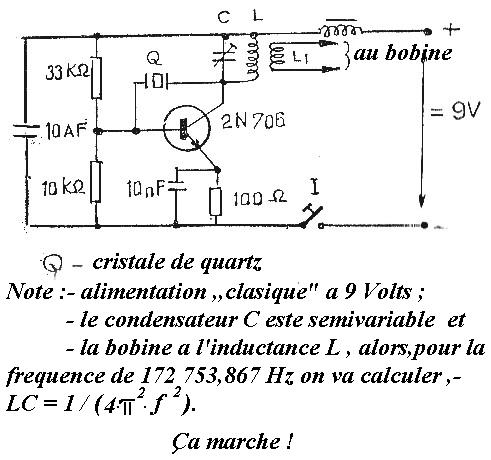A POWER PLANT AT HOME
Document Converted to Text – by hyiq.org
Document Translated by hyiq.org
Originally by Renaud de la Taille.
“Science et Vie” nr.700 March 1976 (pages 42-45 )
While synergetic experiments have been carried out in several laboratories, another
inventor, Michel Mayer, has brought us a power generator with a different principle, but
equally interesting. So, outlined below are two tools that could bring an immense scientific
revolution: energy independence.
It is now more than 50 years since physicists discovered the law of equivalence between
matter and energy: long and arduous work carried out by some of the world’s brightest
researchers to realise the famous equation of Albert Einstein. From that day on we knew
that it is possible to pull thousands of kWh of power from any rock and the practical work
began.
It took a war for the scientists to discover the devastation of a sudden release of energy from
one end of uranium; the bomb proved to show the accuracy of the equation E = MC². After
the first bomb came the second, then the third and subsequently a large deployment of
explosions. Civilisation did not gain much there.
For it to be profitable, energy should be drawn slowly from the field. But apparently, the
researchers knew very little about firecrackers and it took many years to slowly develop very
expensive and dangerous nuclear power plants. And since the official search was for bombs
and these power plants, some individuals deemed it necessary to pursue another path
towards the creation of an individual generator. There were many failures, many enthusiastic
light-bulb moments and some attractive-looking theories, but upon examination most proved
contradictory. Those that were not were very rare, with only the synergistic Professor Vallée
being the case. We have also received many descriptions of process experiments; most of
the time we can detect the error from the drawing. That is to say that we only present the
consistent assumptions that are made or directly reproducible experiments.
And it is this kind of experiment that we report today, which is both amazing and easy to
reproduce by any engineer with certain electrical equipment.
It is the work of a young man from the Alsace in France, Michel Meyer, a science student
whose research is currently directed towards the theory of electrical fields. In his work, he
also draws on the results of wave mechanics and quantum mechanics.
The basic idea is quite simple and is based on the current design of power; it is in fact an
electron moving from one atom to another under the action of an electric field transfer. In a
more general way, all movement of charges are a current; in metals, the case is that of a
current of conduction when a movement of negative charges, the electrons, trigger a
breakdown, well indicated by the presence of a field. But since there is a movement of
charged particles, there is electrical current. As matter is made of atoms, themselves made
up of a positive nucleus surrounded by negative electrons, it is a huge reservoir of charges.
While synergetic experiments are carried out in several laboratories, another inventor,
Michel Meyer, has brought us a power generator of a different principle, but equally interesting. So, outlined below are two tools that could start an immense scientific revolution:
energy independence.
The problem is to set them in motion because, in principle, the electrons are balanced
around the nucleus and it takes energy input to send them in large numbers in the same
direction. This energy input can be the change of a magnetic field – a process used in
alternators, generators, transformers, etc. – chemical reaction – batteries and accumulators –
a ray of light – photocells – and so on. But this power is still brought in from outside, which is
unnatural when you consider that the matter contains considerable energy.
The most interesting generator is neither the dynamo nor the photo-electric cell or battery,
even if it is atomic, but the machine that can draw in electrical form directly from the energy
contained in a metal. It is here that I quote the atomic diagram of wave mechanics, pattern
contribution made by Michel Meyer. The pattern is a bit simplistic but is of the atom as a
small planetary system, with a large nucleus and electrons on very precise orbits.
The concepts of physical designs differ significantly from a beautiful simplicity to becoming
more deterministic statistics. We no longer speak of the electron orbit, but of orbital,
spherical emptiness surrounding the nucleus where it is only likely to find the electron at a
given point. The whole atom is also regarded as an oscillating system, any particles being
bonded to a wave and vice versa. We cannot go any further here, a more accurate
description claiming knowledge of wave mechanics and quantum mechanics of a high level.
We can claim only to understand the invention of Meyer, that every atom is an oscillating
system whose frequency can be held accurately. The basic idea of the electrical generator
relies on the use of a resonant frequency by altering the field of the electron nucleus
connection, therefore diverging the desired orbit. This means that the radius of the orbit
tends to grow indefinitely, which means that the electron leaves the nucleus. Why a resonant
frequency? Because it’s long been known that bringing about an oscillating system with
undulating energy at the same rate amplifies the movement as far as you want and in
general to breaking point.
One case is of the bridge that collapsed because the soldiers crossed it too quickly. And a
crystal glass will break when the tenor launches his/her tenor clef. Thus, any vibrating
system can be set into forced oscillation up to breaking point: it’s enough just to give it a bit
of energy on its appropriate frequency. Since the atom is an oscillating system, it is
understandable that it is possible to switch off the electron resonance. The difficulty with
extremely high frequencies that are associated with electrons is that they oscillate in billions
of cycles per second, which is very much higher than what it is known to produce.
Fortunately, the resonance phenomenon arises not only with the natural frequency of the
oscillator, but with any frequency that is a multiple or submultiple. In other words, if a
standard resonance is 440 cycles per second, it is put in resonance at the frequency 440 Hz
and at both 880, 220, or 110Hz – which is called a harmonic fundamental frequency. The
atom, the frequency and outcome of quantum wave equations is given by the expression
⁄ √
where is the radius of the selected orbital, the electron mass, is the speed of light,
the permittivity of a vacuum, the electron charge and Planck’s constant . Taking copper
as the metal and its orbital conduction for , we find a harmonic for the resonance frequency
at 172 753,867Hz. In practice, it is applied to a coil to provide a magnetic field of the same
frequency. The selected copper metal in this case is dipped in this alternating induction field
and, through resonance; the metal atoms are converted to electron emitters.There is then the creating of a current, which at first sight is not very original. What is more
interesting is that the current produced in copper is very superior to the current required to
maintain the resonance frequency. Under the best conditions of mounting assembly, Meyer
came to a multiplicative factor of 30 to 40: for 1W power consumption to maintain the
frequency, he collected an output of 30 to 40W, which was directly usable. Under the
principle of conservation of energy it follows that the system behaves as a converter that
draws its energy from within the material; the core electron binding energy is converted into
electricity. It is therefore an independent power generator.
In its two aspects, theoretical and practical, the device developed by Meyer offers no major
difficulties. For technology, oscillators capable of reaching hundreds of KHz exist. Those
used in the first experiences have in fact been assembled by the inventor himself according
to the usual pattern of the oscillating circuits: components, inductors, capacitors, transistors,
located in the trade. The disadvantage of these systems lies rather, in their lack of frequency
stability. However, the required harmony must be very exact, representing exactly nine
significant digits with considerable accuracy. The power supply presents, without a problem:
6 to 15 V with a few tenths of amps, it is the power of a few ordinary round batteries. As for
the output current, it is a function of the resistance of the load circuit; if this resistance
decreases, amperage increases as the voltage remains almost constant. Initial tests show
that the limit in this process remains the sever heating of the metal of the generator.
Regarding the theoretical question, we can only leave it to the specialists to discuss with Mr.
Meyer the validity of the assumptions. Note however that these are the result of the most
reliable equations of mechanical wave or quantum and do not challenge current thinking in
physics. Compared to the intrinsic energy of the atomic nucleus, the yield of the apparatus is
of or 0.00001. This is small, of course, but the enclosed energy in a single gram of
material is so huge that the very low yield still meets our energy needs on an individual level.
Also specific to the limits of this device are the limits of nuclear stability, first, because you
cannot pump all the energy from a nucleus without destroying it, or at least seriously
undermining the internal balance. Then the practical limits, a generator of this type is limited
by internal heating, related to the movement of electrons generated by the flow in the
receiver.
The practical realization of the generator will therefore require an oscillator, a coil and a
metal. The most difficult problem is the oscillator because it needs to be highly stable. The
ideal is to use a crystal oscillator, but it is much more expensive than the oscillating circuits
that are more readily available. It (the crystal oscillator) has the advantage of being much
more stable over time. The coil is not a problem; its self-inductance is of the order of a
millihenry (0.4 mH for an installation that we have seen working). The metal must also be as
pure as possible, without spending too much for high chemical purity for the first tests. Meyer
chose copper, but the operating principle is the same with iron or aluminum. Finally, the
receiver circuit can consist of a simple passive resistance to make the action, or by any
power consumer. The most advanced generator is self-sustaining, that is to say that part of
the current obtained is returned to the input to ensure the operation of the oscillator, in the
current experiments, the supply is stabilized at 12V and 0.1A, or very nearly 1W.
But most important for the success of the experiment is the precise value of the frequency,
which requires measurement equipment and high quality control: oscilloscope, multi-meter
and frequency. All of these are very costly.
But this is a device that we have seen working, and unless we admit to a surprisingly
incorrect installation or design, the displayed result shows that it is an entirely new device. At
the beginning we said it was made for a constant for 0.1A. At the end, the multi-meter
showed 20V and 0.38A or 7.2W for 1.2W at the beginning. The output was therefore six times the input, the inventor told us he had obtained, after polarization of the copper
conductor, 45V and 1A, then 45W. The multiplication factor reaches 37 there.
It was not possible to find such a high value when we were there; the frequency could not be
stabilized with sufficient precision. But we do not have any reason to doubt the figures put
forward by the inventor, the main interest remaining in the fact that the device behaves like a
real energy generator. Power setting at start-up has little importance from the moment when
it is only a fraction of the energy recovered at the outlet, it is sufficient to divert a portion of
the output to the input to produce a continuously operating power generator. Note however
that the current delivered at the output is AC, having a frequency between 100 and 1000 Hz.
A suitable device could be reduced to 50 Hz and 220 V for powering standard devices on the
market. It would then provide another converter to ensure the continuous supply of the
oscillator.
Let’s leave for now Meyer’s experimental device. It is actually a small laboratory experiment
easy to reproduce by any technician with the aforementioned equipment, and this is what
makes it so interesting. For if the inventor has not committed any error of interpretation, we
have a device that can significantly alter our civilization to the extent that it can be produced
industrially at low cost. This would mean energy independence for everyone, with all the
resulting benefits. It is hoped that the experience is widely taken up to ensure the widest
distribution if the results are as promising as are the first tests. Of course, the principle has
been patented by Mr. Meyer, who now works at perfecting the equipment to further raise
performance. It has been two months since we talked about the synergistic generator, so
this is a second unit which proves the possibility of operating, for the benefit of all, truly
inexhaustible energy.
THE SYNERGISTIC opponents ALWAYS LOOKS SERIOUS
Our article of November on the synergetic theory and experiments has resulted in a mass of
letters. For the most part, they are from technicians who want to experiment again. Some
had themselves prepared their own assemblies. To all, we had to answer the same thing:
the experiment done in Belgium by Eric Hokar is a prototype installation to test a hypothesis,
not an industrial machine for which we could distribute plans. Now since similar experiences
to that made by Eric Hokar to imitate are underway in several laboratories, it should be noted
that they are under certain critical authorities (including the Faculty of Science), all whom
have said they would not fail to give all the necessary publicity in the case of a negative
result and in the case of a conclusive experiment they would find a good way to explain the
results in the context of classical physics. A very good example of scientific spirit and
intellectual honesty …
Regarding the mail, we will retain only a few passages in the few letters that bring an
element of contradiction. For Mr. Panarmen, a high school science teacher at Quimperlé
Valley is a statement in his own dialectic of long known facts … in the article that there is no
wind … Do not be evil and only note that this view informs us hardly the fault of the
synergistic. In Valencia, he Vergier engineer, he is horrified by the lack of seriousness of our
article on synergistic he raised we wrote 38.87 V / m limit for the electric field instead of
. He says true, but we surprised when he wrote that he found was nothing
in the Valley who fought against the principle of energy conservation while the experiment
described (of Hoker) that it seems a funny of breccia in the wall l true. The conservation of
energy is the basis of the synergistic and obviously found in the experiment that contradicts
anything: the power output from the generator is taken from the diffuse energy of gravitation.
Nothing loses its’ nothing is created. e how he could see the opposite?
Finally, more interesting, Mr. Leborgne, in St-Germain, came across a book published in
1934 was entitled the great secret of the universe gravitation explained by radiation pressure from the ultra-microscopic s-wave. V found on the principle of pressure cosmogony
ubiquitous middle permanent vibrating energy in which we swim. The author, P. Campbell,
Buenos Aires was none other than Ambassador (Argentine. noted that the book was
published by Hachette and the thesis is, indeed, quite synergistic.
Fox size



For shaking atom: and to make them the energy contained therein, must be sent with a high
frequency oscillator (of the order of 173 kHz) wave that is resonant with the vibration of the
electrodes of copper. It through a beautiful field oscillate due to the winding connects to the
oscillator and surrounding copper. Part of running power feels to polarize the metal, which
then returns up to 30 times the energy consumed by the oscillator.Une miniaturale,, centrale electrique Meyer = A miniature, central electric Meyer


Cuivre = Copper
Oscillateur = Oscillator
Aux = to
Consumateurs = consumers
Bobine = Coil
Q – Quartz Crystal
Note: – Power ” classic ” a 9V;
– The capacitor C is semi variable
– The inductor L s, then for the frequency of 172 Hz
We will calculate 753.867 LC = 1 / (4-1r’-f).
It works!
